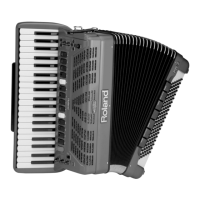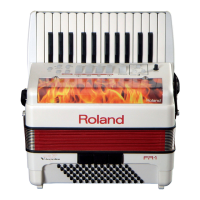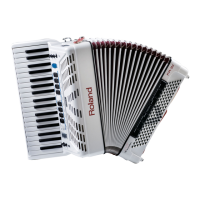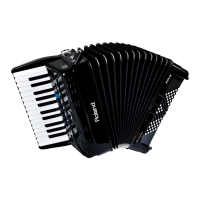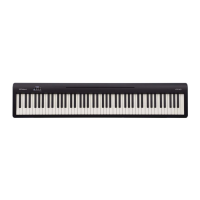70
Menu Options
Parameters Common to the Set (Set Common)
The SET COMMON group contains parameters that apply to all
sections, but only within the framework of the currently selected
Set, most notably the parameters that specify the sound/character
of the Reverb and Chorus effects.
These settings are saved in the selected set.
See “Selecting Parameters” (p. 44) for how to select and adjust
the parameters.
Introduction to Set Common Parameters
The settings for these effects (reverb, chorus) apply to the sound
of all parts in the set.
NOTE
The FR-4x internal memory (temporary area) remembers your settings
while the FR-4x is switched on. While editing, there is no absolute need
to save your settings. Be aware, however, that all changes are lost when
the FR-4x is switched off .
See “How to Save a Set” (p. 33) to save your changes.
Also be sure to read “Important Remark About Saving Your
Settings” (p. 45).
Parameter Explanation
Reverb
(Reverb)
Press the [ENTER/YES] button, and then
edit the reverb settings that are common
to the set.
Chorus
(Chorus)
Press the [ENTER/YES] button, and then
edit the chorus settings that are common
to the set.
Name
(SET Name)
Press the [ENTER/YES] button, and then
edit the name of the selected set (up to
eight characters).
Reverb
Parameter Explanation/Value
Macro
(Macro)
This is an easy way to select effective
settings using the reverb parameters.
It is convenient to choose the basic
reverb settings here, and then use the
following parameters to make fine
adjustments.
“Room 1,” “Room 2,”
“Room 3”: These types
simulate the reverberation
of a room.
They provide a well-
defined spacious
reverberation.
“Hall 1,” “Hall 2”:
These types simulate
the reverberation of a
concert hall with a deeper
reverberation than the
Room reverbs.
“Plate”: This effect type
simulates a plate reverb (a
studio device using a metal
plate to simulate natural
reverb).
Parameter Explanation/Value
Macro
(Macro)
“Delay”: This is a
conventional delay that
produces echo effects.
“Panning Dly”: This is a
special delay in which the
delayed sounds move left
and right.
It is effective when you are
listening in stereo.
Level
(Level)
Set the “Level” parameter of Reverb
processor’s output volume.
The overall reverb volume depends
on three things: the Send level of the
various sections, the output level of the
Reverb processor and the setting of the
[REVERB] knob.
0–127
Charactr
(Character)
This parameter specifies the reverb type
you need.
It does not load preset values for the Pre-
LPF–RevPreDlyTm parameters.
0–7
Pre-LPF
(Pre-LPF)
A low-pass filter can be applied to the
high-frequency range before the signals
coming from the various sections are
processed by the reverb.
Higher values make the Send signals
darker, which results in a mellower
reverberation.
This parameter only applies to the signals
that are sent to the Reverb processor.
It does not alter the sound of the active
sections.
0–7
Time
(Time)
This parameter sets the duration of the
reverb effect.
Higher values result in longer
reverberation.
0–127
DlyFback
(Delay Feedback)
This parameter is only available when you
set “Character” to “6” or “7.”
Feedback returns the delayed signal back
to the input of the delay; this parameter
adjusts the amount that is returned to
the input.
It specifies the number of echoes: higher
values result in more repetitions.
0–127
Pre-DlyT
(Pre-Delay Time)
This parameter sets the time interval
between the original (“dry”) signal and
the onset of the selected reverb effect.
Higher values result in a longer pre-delay
time, simulating a larger reverberant
space.
0–127
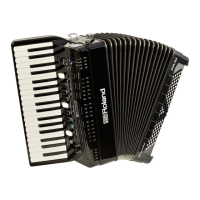
